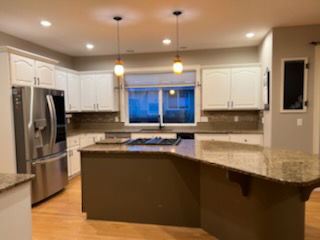Understanding Different Types of Paints and Their Applications

Key Features:
- Diverse Paint Types and Their Uses: The article outlines different types of paints, such as water-based (latex) and oil-based (alkyd) paints, detailing their properties, best uses, and suitability for various applications. This includes discussing where each type of paint performs best, such as latex paints being ideal for interior walls and ceilings due to their quick-drying nature and minimal odor.
- Finishes and Their Applicability: It elaborates on various paint finishes like matte, eggshell, satin, and gloss, and describes the appropriate environments for each. This section helps readers understand how to match paint finishes with room function, highlighting how finishes affect both the aesthetic appeal and the practicality of painted surfaces.
- Specialty Paints and Innovations: The article introduces specialty paints such as enamel and acrylic, explaining their unique benefits and suitable uses. It also touches on innovative and eco-friendly paint options like chalkboard and magnetic paints, emphasizing their specialized applications and benefits for creative and functional spaces.
Selecting the Right Paint for Your Projects
Choosing the correct type of paint is crucial for any painting project, not only to enhance the aesthetic appeal but also to ensure longevity and functionality. The composition of paint directly affects its performance and suitability for specific applications, making it essential to understand the differences between various types of paints and their bases. This knowledge will help you select the ideal product for your project needs, whether for residential, commercial, or specialized applications.
Types of Paints and Their Base
Water-Based Paints (Latex)
Properties: Water-based paints, commonly referred to as latex paints, are renowned for their user-friendly nature. These paints are quick-drying, which significantly reduces the waiting time between coats. They also offer the convenience of easy cleanup with just soap and water. Additionally, latex paints emit less odor compared to oil-based options, making them a preferable choice in living spaces and areas with poor ventilation.
Best Uses:
- Interior Walls and Ceilings: Due to their quick-drying nature and minimal odor, latex paints are ideal for decorating interior walls and ceilings.
- Exteriors: Latex paint is suitable for exterior surfaces because it allows for quick re-coating. Its ability to expand and contract with the siding makes it resistant to cracking and peeling in varying weather conditions.
Oil-Based Paints (Alkyd)
Properties: Oil-based paints, known for their durability, provide a rich, level finish that many professionals favor. The slower drying process allows for a smoother, more uniform appearance, which is particularly appealing on surfaces where finish quality is paramount.
Best Uses:
- Trim, Moldings, and Doors: The toughness and durability of oil-based paints make them excellent for trim, moldings, doors, and other surfaces that encounter frequent use or handling.
- Furniture: For furniture that requires a high-quality finish with enhanced durability, oil-based paints offer the desired aesthetics and longevity.
Specialty Paints
Enamel Paint:
- Features: Enamel paint, often oil-based, is known for its hard, durable finish that resists moisture and wear. It provides a glossy, glass-like finish that is both attractive and functional.
- Uses: Ideal for high traffic areas and rooms with high moisture, such as kitchens and bathrooms, where durability and ease of cleaning are essential.
Acrylic Paint:
- Benefits: Acrylic paints are water-based but offer enhanced properties such as increased flexibility and UV resistance, making them well-suited for exterior applications.
- Exterior Use: The UV resistance helps prevent fading, while the flexibility minimizes cracking, making acrylic paint an excellent choice for outdoor surfaces that need to withstand the elements.
Paint Finishes and Where to Use Them
Choosing the right paint finish is as crucial as selecting the proper paint type. The finish of the paint can dramatically affect the visual appeal of a room and how practical the surface will be in terms of cleaning and maintenance. Here’s a guide to understanding the different paint finishes and determining the best environments for their use:
Matte/Flat Finish
Characteristics:
- Matte or flat finishes offer a non-reflective appearance that helps to hide surface imperfections, making walls appear smoother.
- This finish absorbs light rather than reflecting it, which helps in masking bumps, cracks, and other surface imperfections.
Suitable Environments:
- Ceilings: Flat finishes are ideal for ceilings where light reflection is typically not desired, and surface imperfections are more noticeable.
- Adult Bedrooms: These areas are suitable for flat finishes as they receive less wear and tear, allowing the non-reflective finish to maintain its aesthetic without frequent touch-ups.
- Other Low-Traffic Areas: Any space that does not get a lot of foot traffic or frequent touching, such as formal dining rooms or home offices, can benefit from the elegant look of a matte finish.
Eggshell and Satin Finish
Characteristics:
- Eggshell and satin finishes strike a balance between matte and glossier finishes. They have a slight gloss which isn't overly shiny but offers better washability and durability than flat finishes.
- These finishes reflect light more than flat paint, giving rooms a subtle radiance without the potential glare of higher gloss finishes.
Suitable Environments:
- Living Rooms: Both eggshell and satin are durable enough to handle the moderate traffic of a living room while providing an easy-to-clean surface.
- Hallways and Entryways: These areas often require frequent cleaning due to high use, and the slight gloss of eggshell or satin makes this task easier, all while adding a welcoming glow.
Semi-Gloss and Gloss Finish
Characteristics:
- Semi-gloss and gloss finishes are highly durable and reflective, making them suitable for areas that require frequent scrubbing.
- These finishes highlight details through their shine and are excellent for creating a statement with vibrant colors and crisp lines.
Suitable Environments:
- Kitchen Cabinets and Trim: The durability and easy-to-clean nature of semi-gloss and gloss finishes make them perfect for kitchen cabinets, doors, and trim work.
- Bathrooms: High moisture areas like bathrooms benefit from these finishes as they resist moisture well and can be wiped down easily.
- Furniture: Items that are handled frequently, such as chairs and tables, can withstand wear and tear better with a glossier finish.
Innovative and Specialized Paints for Creative and Eco-Friendly Applications
As the paint industry evolves, so does the range of innovative and specialized paint options available to consumers. These specialized paints not only offer unique functionalities but also cater to growing environmental and health concerns.
Chalkboard Paint
Usage:
- Walls for Writing and Artistic Spaces: Chalkboard paint transforms any wall into a writable surface, making it perfect for kitchens where family members can jot down reminders or shopping lists, or for cafes and restaurants looking to add a creative menu display.
- Children’s Rooms: Ideal for children's playrooms or bedrooms, chalkboard walls encourage creativity and provide a reusable surface for drawing and writing, offering endless entertainment.
Characteristics:
- Chalkboard paint is typically available in black or green but can also be found in a wider array of colors to match any room's decor. It provides a durable, matte finish that can be easily cleaned and reused.
Magnetic Paint
Usage:
- Functional Walls in Home Offices or Kids' Rooms: Magnetic paint can be used beneath a top layer of your chosen paint color to create a magnetic surface without altering the room's aesthetic. This is particularly useful in home offices for attaching notes and reminders directly to the wall, or in kids' rooms for educational purposes and play.
Characteristics:
- Magnetic paint contains tiny metal particles that make it attractive to magnets. It’s usually applied as a base coat and covered with a top coat of regular paint. Multiple layers may be required to strengthen the magnetic effect.
Eco-Friendly Options
Types:
- Low-VOC and Zero-VOC Paints: Volatile organic compounds (VOCs) are chemicals found in many paints that can release harmful gases into the air, affecting indoor air quality and health. Low-VOC and zero-VOC paints minimize or eliminate these emissions, making them safer for both the environment and home occupants.
- Natural Paints (Clay and Milk Paint): Natural paints, such as those made from clay or milk proteins, offer an eco-friendly alternative to traditional paints. They are typically free from synthetic chemicals and are biodegradable, providing an excellent choice for those looking to reduce their environmental footprint.
Importance:
- The shift towards eco-friendly paint options reflects a growing awareness of the health and environmental impacts of traditional paint products. Using these paints can significantly improve indoor air quality and reduce the ecological damage associated with paint manufacturing and disposal. They are particularly beneficial in homes with children, pets, or individuals with allergies or respiratory issues.
In Our Experience:
"Every project at Lightmen Painting reaffirms our belief in the power of using the right materials and methods. Our approach is not just about painting walls but about crafting environments that inspire, endure, and speak to the heart of our client’s needs. Whether it’s choosing the most durable, eco-friendly, or aesthetically pleasing option, our experience guides us to make decisions that enhance both the beauty and functionality of the spaces we transform.For anyone stepping into a painting project, remember, the right paint can make all the difference. Trust in professionals who understand your vision and can bring it to life with precision and care. At Lightmen Painting, we’re here to help you paint not just walls but dreams. Reach out to us for your next project, and let’s create something beautiful together. "
Tips for Choosing the Right Paint: Factors to Consider and Color Selection
Selecting the right paint involves more than just picking a color. Various factors such as the surface material, location, and environmental conditions play crucial roles in determining the most appropriate type of paint for your project. Here’s a detailed guide to help you make the best choices for durability, aesthetics, and maintenance.
Factors to Consider
Surface Material and Location:
- Interior vs. Exterior: Paints formulated for interior use differ significantly from those designed for exterior applications. Interior paints are optimized for a cleaner application and resistance to scrubbing, while exterior paints are developed to withstand the elements like UV rays and harsh weather.
- Type of Surface: The material of the surface you plan to paint affects the type of paint you should use. For instance, wood might require a different type of paint or preparatory treatment compared to metal or drywall.
Weather Conditions and Exposure to Elements:
- Climatic Considerations: If you're painting an exterior surface, consider the climate of your area. High humidity areas might require paint with mold and mildew resistance, whereas sunny areas may necessitate paint with UV protection to prevent fading.
- Environmental Exposure: Analyze the environmental conditions the painted surface will face, such as dust, rain, and temperature extremes, to ensure the selected paint can endure these without deteriorating prematurely.
Desired Longevity and Maintenance Capabilities:
- Durability Requirements: Consider how often you are willing or able to repaint. Some paints are more durable and will last longer but might be more expensive upfront.
- Maintenance Level: Think about how much maintenance you can manage. High-gloss finishes are easier to clean but show more imperfections, while matte finishes hide imperfections but can be harder to clean.
Color Selection
Impact of Color Psychology in Space Planning:
- The color of a room can significantly affect the mood and atmosphere. For example, blues and greens are calming and are excellent for bedrooms or offices, whereas reds and oranges are energizing, suitable for spaces like kitchens or dining areas.
Advice on Testing Colors with Swatches:
- Test Before You Commit: Always test paint colors in your space before making a final decision. Lighting and surrounding colors can dramatically alter the appearance of a paint color.
- Use Swatches on Multiple Walls: Apply swatches to several areas of the room to see how the color looks under different lighting conditions throughout the day.
- Consider Larger Test Areas: If possible, paint larger sections to better understand the color's impact on the entire space. This can help avoid surprises once the whole room is painted.

Application Techniques and Tools: Brushes, Rollers, and Sprayers
Choosing the right tools and techniques for your painting project is crucial for achieving professional-quality results. Each tool offers specific benefits and is suitable for different types of paint and finishes.
Brushes vs. Rollers vs. Sprayers
Brushes:
- When to Use: Brushes are ideal for smaller, detailed work and cutting in at edges. They work well with almost all types of paint and are essential for precision work around trim and corners.
- Why: Brushes allow for greater control and accuracy, making them perfect for tasks that require attention to detail.
Rollers:
- When to Use: Rollers are best for painting large, flat surfaces quickly, such as walls and ceilings. They are suitable for most interior paints and provide a smooth, even coverage.
- Why: Using a roller can significantly speed up the painting process and is less labor-intensive than using a brush for large areas.
Sprayers:
- When to Use: Sprayers are ideal for covering large areas or uneven surfaces where brushes and rollers may not be effective. They work well with exterior paints and finishes, as well as for staining decks or fences.
- Why: Sprayers provide a uniform and consistent finish quickly, even on surfaces that are difficult to cover with other tools.
Preparation Tips
Importance of Surface Preparation:
- Proper surface preparation is key to ensuring the paint adheres correctly and lasts longer. This involves cleaning the surface, making repairs, sanding if necessary, and ensuring the surface is dry and free of contaminants.
Primer Usage:
- When: Primer is necessary when painting over dark colors, raw surfaces (like new drywall or bare wood), or when transitioning from a higher gloss finish to a matte finish.
- Why: Primer helps in providing a smooth, uniform base for the paint to adhere to, which can improve the paint’s durability and appearance. It also ensures better adhesion of the paint, increases paint durability, and provides additional protection for the material being painted.
Conclusion
Understanding the different types of paints, their specific uses, and the right tools for application is essential for any painting project. Whether you're refreshing a room indoors or protecting an outdoor space, the correct approach can significantly impact the quality and longevity of your finish.
Action
For those looking to dive deeper into the world of painting, or who need specific guidance tailored to their unique project, consider reaching out to Lightmen Painting. Visit us for more insights, personalized advice, or to engage our professional painting services. We are here to help ensure your project is a success, combining aesthetic appeal with functional longevity. Visit our website or contact us directly to learn how we can assist with your painting needs.
Do You Have Questions? Give Us A Call With Any & All! 503-389-5758
-
People Also Ask:
What are the advantages of using water-based paints over oil-based paints for interior walls?
Water-based paints, often referred to as latex paints, are favored for interior walls due to their quick-drying properties, which significantly reduce the waiting time between coats. They also emit less odor, making them more suitable for enclosed spaces and improving the comfort of living areas during renovation. Additionally, cleanup with water-based paints is easier, requiring only soap and water, which simplifies the post-painting cleanup process.
How does the finish of paint influence its suitability for different environments?
The finish of the paint can greatly affect both the appearance and functionality of the painted surface. For instance, matte or flat finishes are ideal for ceilings and adult bedrooms as they help hide surface imperfections and provide a non-reflective, sophisticated appearance. On the other hand, glossier finishes like semi-gloss or gloss are suitable for high moisture areas such as kitchens and bathrooms due to their ease of cleaning and moisture resistance. These finishes are also highly durable, making them perfect for high-touch areas like cabinets, trims, and doors.
Why is it important to consider eco-friendly paint options, and what benefits do they offer?
Choosing eco-friendly paint options, such as those with low or zero volatile organic compounds (VOCs), is crucial for minimizing environmental impact and improving indoor air quality. These paints emit fewer harmful chemicals, making them safer for both the environment and the occupants of the home, particularly children, pets, or individuals with allergies or respiratory issues. Additionally, using natural paints like those made from clay or milk protein helps reduce ecological damage associated with traditional paint manufacturing and disposal, aligning with a more sustainable approach to home improvement.
-
SUBSCRIBE TO OUR BLOG: Stay informed with the latest in Painting and DIY projects by subscribing to Lightmen Painting. Get insights, tips, and more delivered straight to your inbox. We would also love to know what you would like to read about, leave thoughts on where we should go next. Interests, Topics, Ideas, all are welcome.
If your in the Portland, Or. area and need advice or a free no obligation estimate call us at 503-389-5758 or email scheduling@lightmenpainting.com
Shout Out:
Celebrating Oregon Museum of Science and Industry (OMSI): A Hub of Discovery and Learning
From the inspired team at Lightmen Painting, we celebrate the Oregon Museum of Science and Industry, commonly known as OMSI. Located in the heart of Portland, OMSI stands as a beacon of science education and innovation, sparking curiosity and wonder in visitors of all ages. Like our detailed and transformative painting projects, OMSI's exhibits and programs are meticulously designed to foster understanding and excitement about science and technology. This museum not only educates but also inspires new generations of thinkers, creators, and explorers, paralleling our goal to inspire through our craft.
Thanks for stopping by Lightmen Daily! Stay tuned for more practical tips and expert advice on making your painting projects flawless, from wall to floor!
Lightmen Painting Serving: Portland, Tigard, Lake Oswego, Tualatin, West Linn, Milwaukie, Sherwood, Happy Valley, Oregon City, Beaverton, Hillsboro, Gresham



